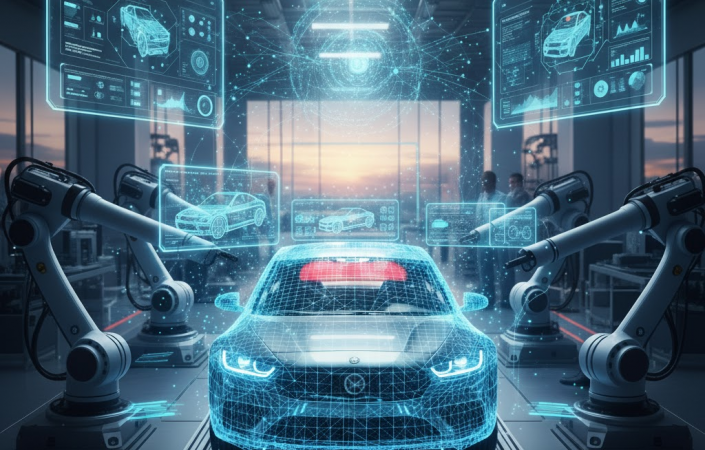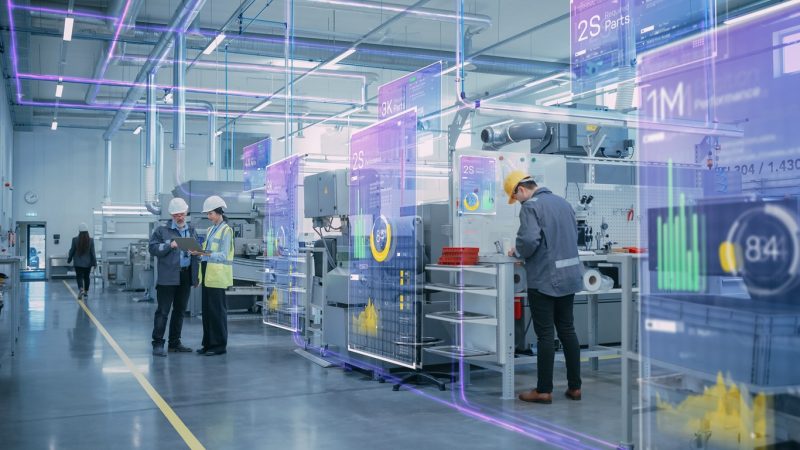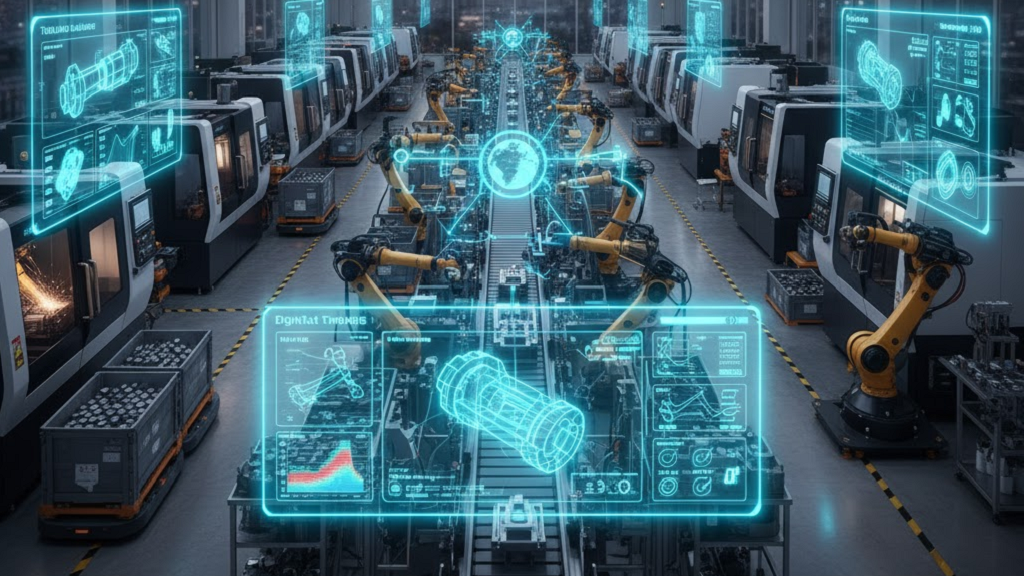Manufacturing Intelligence – Changing The Face of Quality Control
For decades, quality control was the final checkpoint of manufacturing – a line of defense between production and the customer. It was a discipline built around inspection reports, go/no-go gauges, and the belief that catching errors was the best way to ensure quality. But in today’s digital, data-driven manufacturing environment, that paradigm is shifting dramatically. Quality control is no longer an endpoint – it’s becoming the engine room of manufacturing intelligence.
At the center of this transformation is metrology. No longer confined to the walls of a coordinate measuring machine (CMM) lab, metrology is increasingly woven into the very fabric of production, delivering real-time insights that drive decision-making, optimize processes, and close the loop between design intent and manufacturing reality.
This shift from ‘quality control to quality intelligence’ is redefining what it means to make things right the first time.
From Detection to Prevention
Traditional quality control practices have long relied on sampling and post-process inspection to detect non-conforming parts. The challenge was always one of timing: by the time a defect was identified, the problem had already occurred and often repeatedly. Scrap, rework, and unplanned downtime followed.
The manufacturing leaders of today are adopting a different mindset. one that seeks to prevent rather than detect quality issues. This preventive philosophy is driven by metrology data integrated in real-time with production systems, enabling proactive adjustments instead of reactive corrections.
The evolution is made possible by digital technologies that connect inspection equipment, machines, and design systems through a continuous digital thread. This thread links the flow of measurement data to engineering, process control, and enterprise-level decision-making.
When dimensional data is no longer static but dynamic, when it’s analyzed, contextualized, and shared, it becomes a powerful form of ‘manufacturing intelligence’.
The Expanding Role of Metrology
The traditional image of metrology as a slow, isolated laboratory function has been dismantled by advances in sensors, automation, and software connectivity. Today, measurement technologies are faster, more versatile, and more connected than ever.
Modern metrology spans a spectrum of modalities: tactile and optical CMMs, laser scanners, white-light interferometers, structured-light systems, and inline sensors embedded directly in production lines. These instruments can capture millions of data points in seconds, transforming geometric information into high-resolution digital twins of manufactured parts.
But speed alone is not the story. The real power of modern metrology lies in data integration and analytics. Whether in an aerospace machining cell or an automotive stamping line, dimensional measurement data is increasingly fused with machine parameters, environmental conditions, and process metadata.
This convergence turns metrology into an information hub – a system that not only measures geometry but also contextualizes it, revealing why variation occurs and how it can be eliminated.
The Rise of Manufacturing Intelligence
 Manufacturing intelligence refers to the ability to collect, interpret, and act upon production data in a way that continuously improves performance. It bridges the gap between the physical and digital worlds – between the part being machined and the data describing its conformance to design.
Manufacturing intelligence refers to the ability to collect, interpret, and act upon production data in a way that continuously improves performance. It bridges the gap between the physical and digital worlds – between the part being machined and the data describing its conformance to design.
Metrology data is uniquely suited to this role because it is inherently quantitative, traceable, and actionable. Dimensional measurements tell the truth about the product and the process. When combined with advanced analytics, they reveal trends invisible to traditional inspection systems.
As an example, in a modern plant producing precision components for electric vehicles, 3D scanners might collect surface data on 100% of parts. AI-based algorithms analyze deviations in real time, identifying subtle process drifts, perhaps due to thermal expansion or tool wear, and feeding corrective commands back to the machine tool resulting in fewer rejected parts, less downtime, and a continuous feedback loop that enhances both quality and productivity.
This transformation redefines quality control as a strategic function that generates intelligence for the entire manufacturing ecosystem, not just a gatekeeper for defective parts.
Data Connectivity and the Digital Thread
The most profound enabler of this transformation is data connectivity which provides the ability of metrology systems to exchange information seamlessly with CAD/CAM, manufacturing execution systems (MES), enterprise resource planning (ERP), and production equipment.
The digital thread concept encapsulates this evolution. It ensures that every measurement made during manufacturing is traceable to design intent, accessible across departments, and usable for continuous improvement.
When a product’s digital twin is connected to live measurement data, engineers gain visibility into how production realities align, or misalign, with the ideal geometry defined in CAD. Deviations are no longer abstract numbers; they become actionable intelligence for process optimization.
Metrology software platforms such as PolyWorks, ZEISS PiWeb, and others are increasingly the connective tissue of the digital thread, allowing manufacturers to move from isolated measurement reports to real-time dashboards of dimensional performance.
In such environments, data no longer resides in silos—it flows, informs, and empowers.
From CMMs to Inline Inspection
For much of the 20th century, coordinate measuring machines were the gold standard of dimensional inspection. They offered unmatched precision but limited throughput. Today, while CMMs remain indispensable for high-accuracy verification, the trend is toward inline and nearline metrology – bringing measurement closer to the point of production.
Inline measurement systems use optical and laser-based sensors mounted on robots or production fixtures to capture data directly on the shop floor. By integrating these systems with automation and analytics software, manufacturers can detect process variation instantly and implement corrections without stopping production.
Automotive OEMs, for example, now deploy robotic inspection cells that scan entire car bodies within seconds. The resulting 3D data not only verifies conformance but also feeds digital twins used to simulate and optimize assembly operations.
This migration of metrology from lab to line is not just about speed—it’s about transforming measurement data into a live feedback mechanism for process control.
AI and Analytics: Turning Data into Decisions
 The explosion of measurement data generated by the latest sensor technology would be overwhelming without advanced analytics to make sense of it. Artificial intelligence (AI) and machine learning (ML) are increasingly integral to metrology, enabling predictive insights and automated decision-making.
The explosion of measurement data generated by the latest sensor technology would be overwhelming without advanced analytics to make sense of it. Artificial intelligence (AI) and machine learning (ML) are increasingly integral to metrology, enabling predictive insights and automated decision-making.
Machine learning algorithms can detect subtle correlations between part geometry, process variables, and environmental conditions that humans might overlook. Predictive models can anticipate tool wear, machine misalignment, or temperature effects before they cause out-of-tolerance parts.
In some advanced factories, AI-driven inspection planning automatically adjusts sampling strategies based on production variability, ensuring that measurement resources are deployed where they add the most value.
The evolution toward self-optimizing quality systems, where metrology data trains models that in turn guide process control, marks a significant leap toward autonomous manufacturing.
Closed-Loop Manufacturing
The ultimate expression of manufacturing intelligence is closed-loop manufacturing – a system where data from inspection automatically informs and adjusts production processes in real time.
Metrology plays a central role in closing this loop. When dimensional data from an inline scanner or CMM identifies a deviation, feedback signals can be sent to machine controls to correct tool paths, offsets, or process parameters before the next cycle.
This continuous loop eliminates lag between measurement and correction, turning every production run into a learning opportunity.
Closed-loop systems are particularly valuable in industries demanding extreme precision, such as aerospace and medical device manufacturing. They reduce manual intervention, ensure traceability, and provide a foundation for zero-defect manufacturing – a long-standing goal that is finally within reach thanks to digital metrology.
Cloud and Edge Computing: Scaling Quality Data
As factories become more connected, managing the massive volume of metrology data becomes a challenge in itself. Cloud and edge computing architectures are emerging as the solution.
Edge computing allows measurement data to be processed locally, close to the machine, enabling real-time analysis and low-latency feedback. Cloud platforms, on the other hand, aggregate data across multiple sites, allowing enterprises to benchmark performance, detect global trends, and standardize quality practices.
This dual architecture ensures that quality data is both immediate and scalable, supporting both local decision-making and enterprise-level intelligence.
For multinational manufacturers, cloud-based metrology dashboards are transforming how quality is managed—shifting from reactive issue tracking to predictive, network-wide optimization.
Human Expertise in a Data-Driven Era
Despite the growing sophistication of automation and AI, human expertise remains vital. The role of quality professionals is evolving from manual measurement and report generation to data interpretation, system integration, and strategic improvement.
Metrology engineers today must understand not only geometry and tolerancing but also data analytics, network systems, and process engineering. Their expertise bridges the technical and organizational divides that often limit the potential of digital transformation.
This human-in-the-loop approach ensures that while machines process data at scale, people continue to provide context, creativity, and accountability.
The factories of the future will not replace quality professionals but empower them with better data and smarter tools.
Standardization and Interoperability
For manufacturing intelligence to reach its full potential, data must be interoperable across platforms, devices, and suppliers. The industry is increasingly adopting open standards such as QIF (Quality Information Framework) and MTConnect, which define common data formats for measurement and process information.
These standards allow inspection data to move freely between metrology software, machine tools, and enterprise systems, eliminating costly data silos.
By embracing interoperability, manufacturers gain the agility to integrate best-in-class technologies while maintaining a unified view of product and process quality.
This standardization is a key enabler of the Smart Factory, where every asset contributes to a shared understanding of performance and quality.
Sustainability Through Quality Intelligence
The changing face of quality control is not only about precision and productivity—it’s also about sustainability. By reducing waste, rework, and resource consumption, intelligent quality systems directly contribute to environmental goals.
Metrology-driven manufacturing intelligence ensures that materials are used efficiently, machines operate within optimal parameters, and production lines deliver right-first-time quality.
Moreover, data transparency enables manufacturers to demonstrate compliance with sustainability standards and traceability requirements across global supply chains.
In this sense, the pursuit of manufacturing intelligence is also the pursuit of responsible manufacturing.
The Path Ahead
As manufacturing enters the era of Industry 4.0 and beyond, the role of metrology is expanding from measurement to management – from verifying parts to orchestrating processes.
The next frontier will be autonomous quality ecosystems, where metrology data, machine intelligence, and digital twins operate in concert to self-correct and self-optimize production in real time. In such environments, quality will no longer be a department – it will be an emergent property of the manufacturing system itself.
The transformation is already underway, and its implications are profound. Manufacturers who harness metrology as a source of intelligence, not just inspection, are building the foundation for a new era of competitiveness, agility, and trust. The face of quality control is changing—from a reactive, compliance-driven function to a proactive, intelligence-driven discipline. Metrology is at the core of this evolution, providing the data, traceability, and insight needed to make manufacturing not just smarter but fundamentally better.
As measurement becomes digital, connected, and intelligent, the boundaries between inspection, process control, and production are dissolving. The future of manufacturing will not be defined by how well we measure what we make – but by how intelligently we use measurement to make what we measure better.
Editor



